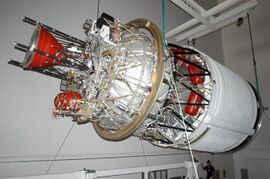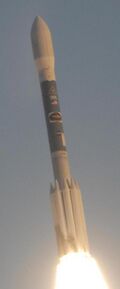Engineering:Delta Cryogenic Second Stage
 A 4-meter DCSS from a Delta IV Medium | |
| Manufacturer |
|
|---|---|
| Country of origin |
|
| Used on |
|
| Launch history | |
| Status | Active |
| Total launches | 45 |
| Successes (stage only) | 42 |
| Failed | 2 (Delta III) |
| Lower stage failed | 1 (Delta III) |
| First flight | 27 August 1998 |
| Delta III second stage | |
| Length | 8.8 m (29 ft) |
| Diameter | 4 m (13 ft) (LH2 tank) 3.2 m (10 ft) (LOX tank)[1] |
| Empty mass | 2,480 kg (5,470 lb) |
| Gross mass | 19,300 kg (42,500 lb) |
| Engines | 1 × RL10B-2 |
| Thrust | 110.1 kN (24,800 lbf) |
| Specific impulse | 462 s (4.53 km/s) |
| Burn time | 700 seconds |
| Fuel | LH2/LOX |
| Delta IV 4-meter second stage | |
| Length | 12.2 m (40 ft) |
| Diameter | 4 m (13 ft) (LH2 tank) 3.2 m (10 ft) (LOX tank)[1] |
| Empty mass | 2,850 kg (6,280 lb) |
| Gross mass | 24,170 kg (53,290 lb) |
| Engines | 1 × RL10B-2 |
| Thrust | 110.1 kN (24,800 lbf) |
| Specific impulse | 462 s (4.53 km/s) |
| Burn time | 850 seconds |
| Fuel | LH2/LOX |
| Delta IV 5-meter second stage | |
| Length | 13.7 m (45 ft) |
| Diameter | 5 m (16 ft) (LH2 tank) 3.2 m (10 ft) (LOX tank)[1] |
| Empty mass | 3,490 kg (7,690 lb) |
| Gross mass | 30,710 kg (67,700 lb) |
| Engines | 1 × RL10B-2 |
| Thrust | 110.1 kN (24,800 lbf) |
| Specific impulse | 462 s (4.53 km/s) |
| Burn time | 1,125 seconds |
| Fuel | LH2/LOX |
| Interim Cryogenic Propulsion Stage | |
| Length | 13.7 m (45 ft) |
| Diameter | 5 m (16 ft) (LH2 tank) 3.2 m (10 ft) (LOX tank) |
| Empty mass | 3,800 kg (8,400 lb) |
| Gross mass | 32,748 kg (72,197 lb) |
| Engines | 1 × RL10B-2 or RL10C-2 |
| Thrust | 110.1 kN (24,800 lbf) |
| Specific impulse | 462 s (4.53 km/s) |
| Burn time | 1,125 seconds |
| Fuel | LH2/LOX |
The Delta Cryogenic Second Stage (DCSS) is a family of cryogenic-fuelled rocket stages used on the Delta III, Delta IV, and on the Space Launch System Block 1 launch vehicles. The DCSS employs a unique two-tank architecture where the cylindrical liquid hydrogen (LH2) tank carries payload launch loads and forms the upper section. An oblate spheroid tank filled with liquid oxygen (LOX) and the engine are suspended from the LH2 tank and covered by the interstage during initial launch.
The DCSS is powered by a single RL10B-2 engine built by Aerojet Rocketdyne,[2] which features an extendable carbon–carbon nozzle to improve specific impulse.[3]
The DCSS was designed by the National Space Development Agency of Japan, based on the second stage it developed for the H-IIA rocket. The initial versions for the Delta III were built by Mitsubishi Heavy Industries in Japan. For the Delta IV, production was transferred to Boeing Integrated Defense Systems and later to United Launch Alliance.
Delta III
The DCSS first flew on three Delta III missions, however it was never successful. On its maiden flight, a booster failed and the rocket was destroyed by range safety, causing the loss of the DCSS before ignition. The second mission saw the DCSS itself malfunction tumbling uncontrollably, inserting the payload into a useless orbit. On the third flight, the DCSS performed its planned burn but fell short of the target orbit due to premature propellant exhaustion, resulting in mission failure.[4] An un-flown example is on display outside the Discovery Cube Orange County.[5]

Delta IV
The Delta IV launch vehicle utilized two distinct versions of the Delta Cryogenic Second Stage (DCSS) to cater to the specific launch needs. These variants are the original DCSS with a 4-meter (13 ft) diameter that is largely identical to the version used on the Delta III and the larger version with a 5-meter (16 ft) diameter used to lift larger payloads.
These variations necessitated the use of composite interstages, which linked the first and second stages together. For the Delta IV Medium configuration, a tapering interstage was employed to transition between the 5-meter diameter of the first stage and the smaller 4-meter diameter of the DCSS. In contrast, the Delta IV Heavy configuration and some Delta IV Medium+ configurations, with larger payload capacities, utilized a cylindrical interstage that matched the diameter of its 5-meter DCSS.[3]
The Delta IV family of rockets has been retired, with a final launch on 9 April 2024.[6]
Interim Cryogenic Propulsion Stage
The Interim Cryogenic Propulsion Stage (ICPS) serves as the upper stage for the initial configuration (Block 1) of NASA's Space Launch System (SLS). It's a derivative of the 5-meter DCSS, with minimal modifications for SLS integration. Like the earlier DCSS, the ICPS is powered by one Aerojet Rocketdyne RL10 engine and generates 110.1 kilonewtons (24,800 pounds-force) of maximum thrust.[7] Like all previous DCSS units, Artemis I used the RL10B-2 engine, however Artemis II and III will use the RL10C-2.
The ICPS for the Artemis I mission was mated to the SLS launch stack on 6 July 2021.[8][9] It performed as expected, providing the necessary thrust during the successful launch on 16 November 2022 at 06:47:44 UTC (01:47:44 EST).[10]
The ICPS is designed as a temporary solution and slated to be replaced by the next-generation Exploration Upper Stage for the Artemis IV mission and beyond.[11]
References
- ↑ 1.0 1.1 1.2 "Delta IV Launch Services User's Guide". United Launch Alliance. https://www.ulalaunch.com/docs/default-source/rockets/delta-iv-user's-guide.pdf.
- ↑ Robert A. Braeunig (2 November 2009). "Space Launchers—Delta". Rocket and Space Technology. http://www.braeunig.us/space/specs/delta.htm.
- ↑ 3.0 3.1 "Delta IV Payload Planners Guide". United Launch Alliance. September 2007. pp. 1–5 to 1–6. http://www.ulalaunch.com/site/docs/product_cards/guides/DeltaIVPayloadPlannersGuide2007.pdf.
- ↑ "Delta 8930". http://www.astronautix.com/d/delta8930.html.
- ↑ Dave Nordling (8 October 2017). "Discovery Cube – Orange County". Reaction Research Society. https://www.rrs.org/2017/10/08/discovery-science-foundation/.
- ↑ "'Heavy' history: ULA launches final Delta rocket after 64 years (video, photos)" (in en). 9 April 2024. https://www.space.com/final-delta-4-heavy-rocket-launch-nrol-70.
- ↑ Braeunig, Robert. "SPECIFICATIONS & TECHNICAL DATA: Space Launch System". http://www.braeunig.us/space/specs/sls.htm.
- ↑ Chris Bergin (4 October 2011). "SLS trades lean towards opening with four RS-25s on the core stage". NASASpaceflight.com. http://www.nasaspaceflight.com/2011/10/sls-trades-opening-four-rs-25s-core-stage/.
- ↑ Rosenberg, Zach. "Delta second stage chosen as SLS interim". Flight International, 8 May 2012.
- ↑ "Artemis 1". NASA. https://nssdc.gsfc.nasa.gov/nmc/spacecraft/display.action?id=2022-156A.
- ↑ Bergin, Chris (3 February 2020). "Upper Stage RL10s arrive at Stennis for upcoming SLS launches" (in en-US). https://www.nasaspaceflight.com/2020/02/upper-stage-rl-10s-stennis-sls-launches/.
External links
 |

